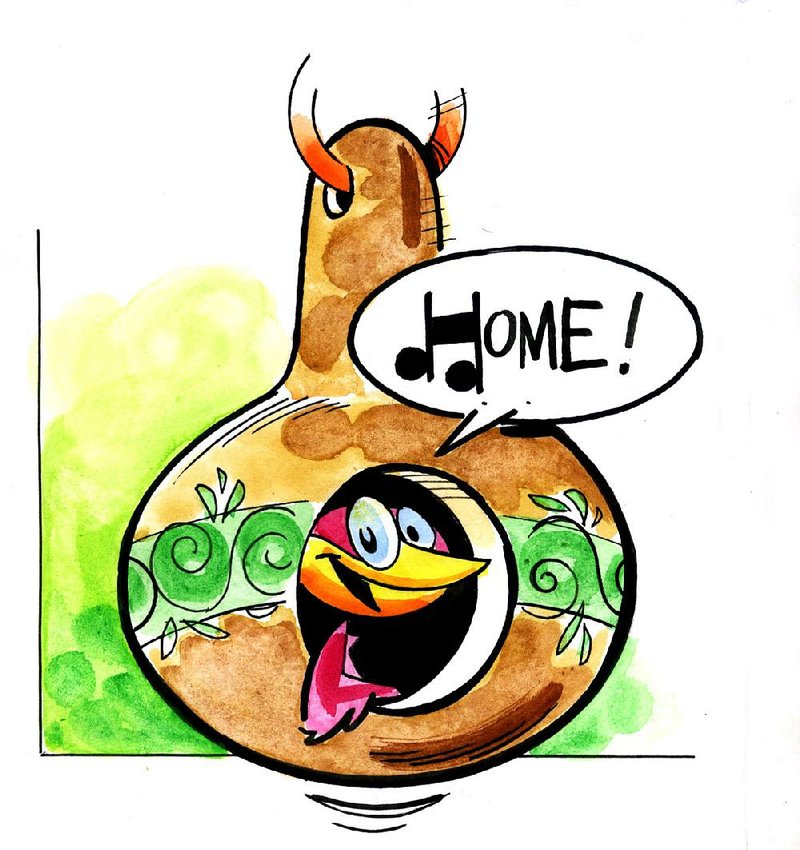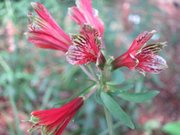Q A friend gave me some seeds for gourds for birds' nests. I planted them, and they're a few feet tall now and probably need fertilizer. What type should I use and how often should I apply it? Is this vine an annual or will it come back on its own next year? If I do get gourds, how do I treat them to make bird nests?
A I assume you are referring to birdhouse gourds, the ones that grow 10 to 12 inches long and taper at one end, which is convenient for hanging. They should have been fertilized at planting with a complete fertilizer (something with all three numbers like 10-10-10) and again six to eight weeks into the growing season. Too much nitrogen will encourage rapid vine growth and can deter fruit set. To get the prettiest shape, you could grow them on a trellis so the gourds will hang down straight. The fruits should mature in the fall, and the outer shell will become hard. When harvesting, be sure to leave an inch or two of stem attached. Cure the gourds in the shade for a few days after harvesting. Wash dirt off and rinse the gourds in a weak bleach solution. Hang them on wires in a warm, dry area until they're completely dry. Then make them into a birdhouse. The plant is an annual vine, so save some seeds if you wish to replant next season.
Q Would you please identify this plant for me? I have had it forever and have just called it hummingbird plant, but some of my friends want to get one, and we don't know the real name.
A The plant is a hardy alstroemeria lily, Alstroemeria psittacina. This member of the amaryllis family is a native of northern Brazil. Common names are Peruvian lily or parrot flower. The blooms on this species are about half the size of the Alstroemeria lilies you buy as a cut flower, but the plants are much hardier. They grow from a small, white tuber (bulb). They have survived in my garden for eight years. I have them in too much shade, so they don't bloom as well as they could. They are best in morning sun or filtered sunlight. Protect them from the hot afternoon sun.
Q I have a plant that is coming back in my garden that looks just like the salvia I planted last year. Or maybe it is a weed. I did not think salvia was a perennial. Could it have been the mild winter?
A While many plants are coming back from last year that normally wouldn't, there are many great perennial salvia varieties. There are some salvia varieties that are annuals, and some are evergreen, like the culinary edible sage (Salvia officinalis).
Q I lost my live oak in the front yard and that covered a shade garden. Too much ice and green leaves. I am looking for a unique, colorful, attractive tree for a replacement. Grancy gray beard has caught my attention. Looks good in April, and it's unique. I don't see a lot of these trees in the area. Not much color after blooming however, and no fall foliage. I would like to get your thoughts concerning this fringe tree as a replacement. I have looked at the extension service list of trees. Several would be satisfactory.
A Grancy gray beard or fringe tree (Chionanthus) is a great small tree, not too exciting after bloom, but a nice addition to the garden. Chinese pistache is a great small tree with outstanding fall color. Little leaf linden is a larger tree at maturity with small white blooms that the bees like. And the summer-flowering golden rain tree is another attractive option.
Q Can you please tell me where (locally or from a reputable catalog) I could buy a lemon tree?
A Most local nurseries sell citrus trees along with their flowering tropical plants. Meyer lemon is probably the most common.
Q My dear friend, Charles, would like your advice on getting Spanish moss restarted in his yard. He got some from New Orleans. He enjoys your column so much.
A Spanish moss is not Spanish or a moss, but an epiphytic flowering plant. Epiphytes live on a host plant but make their own food, unlike a parasite, which takes from the host. The epiphyte uses the trees it grows on as support, nothing else. The plant has no roots but takes its nutrients from rainfall and airborne dust. Its slender, wiry, long-branching stems and leaves are covered with overlapping silver-gray scales, which help absorb water and trap dust and nutrient particles. The stems can grow longer than 20 feet. Spanish moss grows on trees in areas of high humidity and high temperatures. It is winter hardy to about 22 degrees. Tell him to find a tree with some low-hanging branches and drape the moss in it. It would have survived last winter just fine but would not have been so happy during the two earlier, and colder, winters.
Janet B. Carson is a horticulture specialist for the University of Arkansas Cooperative Extension Service. Write to her at 2301 S. University Ave., Little Rock, Ark. 72204 or email her at
jcarson@arkansasonline.com
HomeStyle on 06/04/2016

